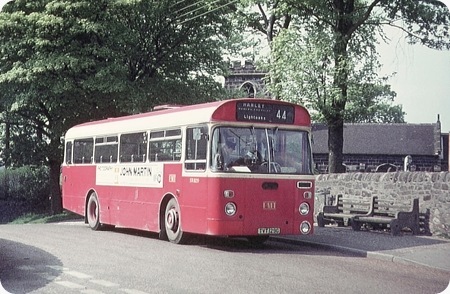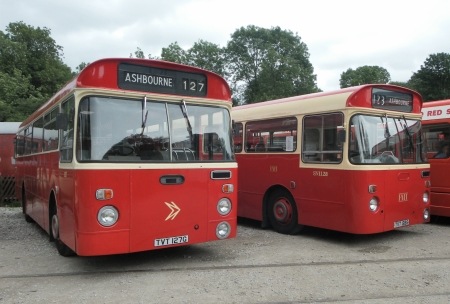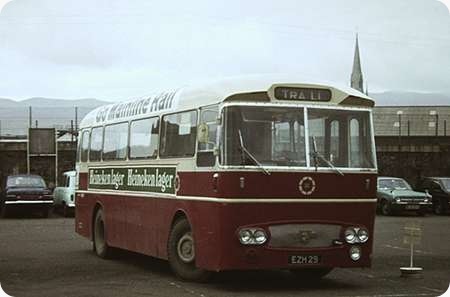
Copyright Ian Wild
Potteries Motor Traction
1968
Leyland Leopard PSU4A/4R
Marshall B43F
A pleasant Sunday afternoon scene in May 1970 outside the church at the Bagnall terminus of service 44 from Hanley shows one of Milton Depots pair of short Leopards. This batch of 20 buses was a welcome relief after the 48 Daimler Roadliner buses delivered in the previous three years. These short length Leopards were ultra reliable machines and ideal for the rural services operated by Cheadle, Longton, Newcastle and Milton Depots where they replaced early AEC Reliances.
Photograph and Copy contributed by Ian Wild
24/08/12 – 08:19
Nice shot!
"This batch of 20 buses was a welcome relief after the 48 Daimler Roadliners . . ." All I have read about the Roadliners indicates that the term ‘unmitigated disaster’ is too mild. How could Daimler have got it so wrong?
Pete Davies
24/08/12 – 08:20
Said in three simple words – ultra reliable machines. Never was convinced that Volvo were that much batter than AEC but Leyland suffered from association with British Leyland (Motor Corporation). I have great respect and affection for the Leopard, AN68 and Tiger. They may not have been as flash or quick as the Volvos but they plodded on – you trusted them to keep going.
David Oldfield
24/08/12 – 12:19
A pair of these are preserved namely 1127 – TVT 127G and 1128 – TVT 128G
Chris Hough
24/08/12 – 12:20
Pete. Everyone got it wrong apart from Bristol with rear engined buses – Daimler got more wrong than anyone else, especially choice of engine. As a "coach" man, my top three are ZF Reliance, RE and Leopard. I preferred the Leyland engined RE and, significantly, PMT turned to the RE – albeit late in the RE’s lifespan.
David Oldfield
25/08/12 – 07:40
David,
Ta! I had an idea that most of the problem was the choice of engine.
Pete Davies
25/08/12 – 07:42
David, you can add Seddon to the list of rear engined design failures. No doubt because of his debt of gratitude to Robert Seddon in the early years of his engineering career, Geoff Hilditch, in his writings, is quite kind about the shortcomings of the Pennine RU, but it was undoubtedly a severe disappointment to those who tried hard to encourage competition with British Leyland. The only really satisfactory Seddon psv design was the Pennine VII, which proved to be a sound and reliable performer.
Roger Cox
25/08/12 – 07:42

Re Chris Hough’s posting of 24/08/12 12:19 about the two preserved PMT Leopards 1127 & 1128, here is a photo I took of them both at the Wirksworth Bus Rally at the Ecclesbourne Valley Railway on 1st July this year.
Eric Bawden
25/08/12 – 08:53
As always, seeing sisters side by side highlights the detail differences. In this case, the indicator displays, the "company" logo versus the NBC one on the front, the little ventilator under the windscreen . . . And this is just from a look at the bus front!
Pete Davies
25/08/12 – 10:54
Pete. There was another problem that everyone except Bristol had, as well. Heavy engines overhanging the rear axle causing bodies, and chassis, to flex (and sometimes break). Ingenious use of the Lodekka drop axle enabled Bristol to shorten the overhang on the RE and thus reduce the stresses on both chassis and body. The Seddon RU mentioned by Roger was, as much as anything, meant to be an RE clone to help RE operators out who were suffering delivery delays (a "British Leyland" problem with all their brands at the time). Crosville bought hordes of the things and were stung. The Ward Dalesman GRX was a further unsuccessful attempt. The Seddon Pennine VII, on the other hand was a "Leopard with Gardner engine" that "British Leyland" refused to supply to the Scottish Bus Group.
David Oldfield
25/08/12 – 12:27
And we all know what happened to British Leyland over their perceptions of what the customer wanted and what they were prepared to supply: among other things, we got foreign trucks and buses, and cars with traditional boot lids (even on cars with the hatchback shape) when other car makers were introducing hatchbacks, etc!
Pete Davies
27/08/12 – 07:53
A common consensus is the generally uselessness of early rear engined saloons Interestingly some operators managed to make the beast work. Preston made the Panther work as did Hull equally Leeds 150 Swifts had a normal lifespan. While others quickly sold them off as to fault prone or too costly to maintain.
I suppose that fashion also played a part whereby if undertaking A was getting rid of the things undertaking B down the road would do as well.
To my mind this meant that Leyland could pour money into the National and not further develop the other chassis particularly the Bristol RE which was streets ahead of anything similar from the Leyland empire.
Chris Hough
28/08/12 – 14:35
These Leopards were awful (my opinion) it was all down to the cab layout the windscreen was about 6 feet away so you had to stand up to wipe the screen also had a low driving position. The only good thing was they were warm in the winter. we operated them on the Newcastle – Market Drayton service (64) and the other problem was they did not have a AEC Badge on the front.
Michael Crofts
28/08/12 – 17:55
Well, Michael, I will agree with you wholeheartedly on the matter of AEC, but have to say that Devon General’s similar AH505 Reliances – ie with Marshall bodies – had similarly huge cabs with the screen miles away. So you can blame Leyland for the low driving position, which they rectified on Leopards after 1969, but Marshall are to blame for your trek to clean the screen!
[I assume you were after an AEC chassis and engine behind the badge? I knew a coach operator in High Wycombe (Bucks) who ran a Reliance with a Bedford engine…..!]
David Oldfield
28/08/12 – 17:56
All Leylands had that problem, Michael!
Eric Bawden
29/08/12 – 07:23
Just noticed another difference, on the two preserved examples (1127/8). 1127 has sliding vents behind driver’s signalling window, 1128 doesn’t.
David Oldfield
29/08/12 – 12:20
We had three similar Leopard PSU4/Marshalls to this at Halifax. 358-360 (NHE 8-10F) came to Calderdale J.O.C. from Yorkshire Traction as part of the Todmorden takeover arrangements. Nice enough looking buses, they too suffered from the faraway windscreens and very low driving position. They had the original style of large Pneumocyclic gearchange pedestal which got completely in the way, and to get in and out of the cab seat required the skills of a contortionist. With the seat wound up high enough to see forward and reach the pedals one’s knees were rubbing against the underside of the steering wheel, and one’s left leg had a struggle to fit around the gearchange pedestal. They were extremely uncomfortable and inconvenient buses to drive.
Despite the relative indestructability of the earlier Leopard chassis, I am told that the build quality of the Marshall bodies left a lot to be desired. Despite the apparent similarity of the BET-style bodies built by various bodybuilders, it would seem that some were a lot better than others, and that the Met.Cam/Weymann version was generally the most durable.
Despite this, 360 was badly damaged in a collision and sold to a Barnsley breaker, but later it turned up in Malta rebuilt and magnificently presented by one of the island’s most enthusiastic bus owners.
John Stringer
19/01/13 – 06:12
Having owned a Marshall bodied short Ribble Leopard for almost 15 years I find it hard to believe that they were such poor service vehicles. I must admit there is a certain amount of dexterity required to become seated in the drivers seat, but once seated I have not yet found any problem with the driving position. Surely windscreens on most half cabs and other 1960’s vehicles are a similar distance away? Whilst I have not driven this particular bus fully laden, the steering could be entertaining, I find it a pleasure to drive.
John Davis
20/04/13 – 07:17
Re- remarks on variations with 127/128, yes there’s lots more inside and out, we have a boot but no doors, 127 has a disabled chair lift! 127 has 2 roof vents, 128 has 1, coach seating in 127, service seats in 128. The luggage racks differ, as do cabs, as 128 was altered along with destination box layout by previous owner. I cannot explain, or took the time to find out why all this happened, as owner/secretary of ‘TVT 128G group’ what I can say is that 128 has served us well over the 13 years we have owned her, no major repairs other than a radiator leak/broken jubilee clip/1 leaf spring but she’s a good runner.
Keith Broomhall
 Vehicle reminder shot for this posting
Vehicle reminder shot for this posting
20/07/15 – 06:49
Enjoyed a couple of laps around Oulton Park yesterday aboard TVT 128G, one sighting lap and one ‘fast’ lap! Wouldn’t have been half as much fun on a modern bus.
Wayne Hope





